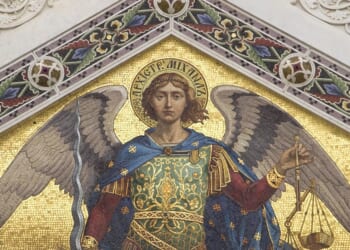LADY Margaret Roper was arraigned before the King’s Council, after the execution of her father, Sir Thomas More. She admitted taking his head from a spike on London Bridge before it was cast into the water to make way for the head of another hapless victim. But, she insisted, she had not taken it as a relic, but to bury it rather than let it “be food for the fishes”. One report said that she was interred with the head in her arms in the family vault in St Dunstan’s, Canterbury.
The news that the PCC there is considering exhuming the skull to conserve it before the 500th anniversary of the saint’s death (News, 18 July) has coincided with the opening at the Harold Pinter Theatre in London of a touring production of Robert Bolt’s play A Man for all Seasons. It has made me consider reputation as relic.
Thomas More is, more properly, A Man For All Eras. His shifting image across the centuries tells us as much about the ages that reimagined him as about the man himself. His contemporary Erasmus praised his friend’s “extraordinary kindness and sweetness of temper” and “humour and playfulness”, describing a witty, humane, learned, and devout man. It placed More at the heart of the European Renaissance before the Reformation fractured it.
Protestant polemicists saw a different man. John Foxe portrayed a persecutor of true believers, Eamon Duffy wrote in the TLS in 2020. More’s wit became sarcasm, his learning pedantry, his piety fanaticism. This was a More for an England that needed to justify the break with Rome. His was a cautionary tale of misplaced loyalty.
Next, recusants such as Nicholas Harpsfield clandestinely wrote of More as a Christlike martyr, his death transfigured into a Passion narrative. Recusant etchings stripped away More’s courtly finery, showing him in plain robes, with softened expression and prayerful pose.
The 18th century secularised the saint. Enlightenment thinkers lauded More the philosopher. The ideal commonwealth of his Utopia was applauded as a proto-republican vision. The engraver Houbraken included him in his series “Heads of Illustrious Persons of Great Britain”.
The Romantic era, with its Catholic Revival and Oxford Movement, fitted More to a different mould. A new generation of Catholic poets admired More for his “splendid virtues of faith and steadfastness” and the newly fledged Catholic Truth Society published devotional hagiography portraying a man of faith standing against a corrupt court.
In the liberal age, Bolt, a secular playwright, portrayed the saint as a democrat in period costume. The Cold War West saw an heroic individual conscience standing against the arbitrary power of the State. His pioneering education of his daughters made him a proto-feminist, Jonathan Jones reported in The Guardian in 2015. The anti-communist pope, John Paul II, made him patron saint of politicians.
Finally, Hilary Mantel’s Wolf Hall has done for Thomas More what Shakespeare did for Richard III. Mantel’s perverse inversion of the historical facts speaks of more than her own virulent anti-Catholicism (see First Things in 2015). Transforming More into a cruel self-righteous fanatic — and the thuggish apparatchik Thomas Cromwell into a sensitive hero — speaks to our age’s venal materialism, suspicion of religion, and secular-liberal appetite for antiheroes.
This production of A Man for All Seasons is billing Thomas More as “a man of integrity, loved by the common people”. It will be interesting to see how they will make that work.















